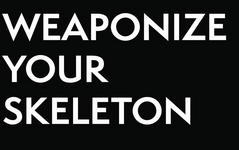Knowing the Stakes and Acting Accordingly…
…is a ton of crap.
Let me rewind a little bit.
The concept of the universality of violence is a key idea that we come back to time and time again, that is, treating all violence as equivalent, with no such thing as “dash”-fighting, e.g., ground-fighting, knife-fighting, stick-fighting, etc. The reason we have to keep coming back to it is because a lot of the time you don’t treat it as equivalent; add a firearm, for example, and you think the stakes are different, and you suddenly want your performance to reflect “how serious” you believe the situation has become. Sometimes you think it’s just social status at stake, or mere wounding. But when the knife or the gun comes out, then it’s different, right? Now you’re playing for keeps, and so you have to get serious. Now you know the stakes and want to act accordingly.
I call bullshit.
Let me put it this way: you really don’t want to know the stakes. You never want to find out if it was life or death, because you know how you’ll know? When they’re killing you, that’s how. That’s a stupid, behind-the-curve way to find out. It’ll be the last thing you ever know. At that point the information will do you no good.
If your mat time is focusing on the idea that your workout partner is “empty-handed” and so the stakes are a mere beating, you’re probably being sloppy with distance and penetration—letting them have too much of the former and not doing enough of the latter. Then, when you add a firearm into the mix, now it’s on, right? Everything changes, you have to tighten up, “get serious”, etc. You know what you’re really doing? You’re training to get yourself killed.
Every time you go physical it’s for keeps. Every time you yank out the fail-safes and go off on someone it’s serious. Every. Single. Time. You need to take every turn you get in training as the “real deal.” Treat your partner as if they were armed with a firearm, or a knife—because they just might be armed with something worse. They might be carrying what I carry:
A bear trap and a pack of wolves.
I never leave home without them. In fact, they’re with me constantly. Now, you might think I’m being funny or losing my mind and to that I would ask that you review any video you have of instructors free practicing. Notice that once it starts, there is no escape. The reaction partner doesn’t get the opportunity to do much of anything other than react, fall, and get torn apart.
This is what I think of when someone asks me if I’m a sheep, a wolf, or a sheepdog. (Actually, the first thing I think of is that I’m Homo sapiens, a human being, something much, much worse than any of the above. But then, we’re all human and probably far too close to it to see just how incredibly powerful an animal we are. Hands-down the apex predator of the entire planet. But I digress.)
So, if I have to pick a different animal, I’ll pick the way it feels when I free practice—like a bear trap and a pack of wolves. The trap set, powerful springs straining beneath a hasty cover of leaves and forest detritus, and a pack of lean, tawny wolves circling in the shadows. Once the trap is sprung, there is no escape—after the steel jaws of the initial strike splinter bone and sunder flesh, the wolves are free to tear the crippled person to pieces.
Why does instructor free practice look like this? Because the instructor knows the stakes ahead of time. It’s all or nothing, every time. And once that trap is sprung, there is no escape. Starting right now, here are three things you can do to get there:
– Throw out the idea that the stakes are variable.
Treat every turn on the mats as if your partner has a knife, or a firearm, or, worst-case-scenario, a bear trap and a pack of wolves.
– Be the bear trap and the pack of wolves.
Once you start, it’s all about you. They get to do nothing but react, fall, and get torn to pieces. They don’t get to stagger back. They don’t get to roll away. Get inside and stay there, right on top of them—the maximum distance between the two of you should never be greater than one step/strike. Ideally, you’ll be pretty much torso-to-torso the entire time. Make “there is no escape” your personal violence motto—and then make it a reality.
– Work on making universality a reality for you.
Violence is not a bunch of disparate things all duct-taped together into an unwieldy Frankenmass. It’s a singularity. It’s just one thing. It has a single use. You can’t dial it up and down, “go easy” or be nice. You do not inflict it upon the “unarmed” man any differently than you would an armed one. (Think about how dangerous you are, naked, with nothing but your bare hands and intent. As dangerous as a steel bear trap and a pack of hungry wolves, perhaps?)
You need to walk into every mat session with these three things in mind because you need to act identically in every violent situation—spring the trap and maul at will. Every free practice should feel the same—guns, knives, batons or not. If it feels different with the gun, if it feels stressful or “more real”, you’re missing the point when it’s not there—it means you’re not taking any of the rest of it as seriously as you should. The obvious, projected intent of the firearm is taking you where you should be all the time in your free practice. Buckle down, focus, and free practice to make the tool in the hand truly immaterial—get the job done so that it really doesn’t matter what they have, even if it’s a bear trap and a pack of wolves.
— Chris Ranck-Buhr (from 2007)



Leave a Reply
Want to join the discussion?Feel free to contribute!